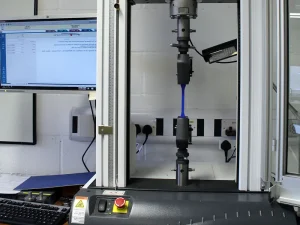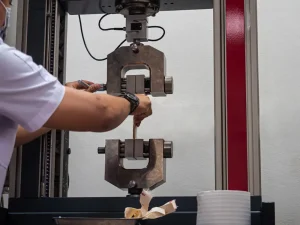What is tensile strength? This question pops up when you see this term written on the labels of various products. Tensile strength is considered an indicator of how strong a material is. However, this is not complete information as this term has a broad scope. Many industries rely on it when choosing raw materials.
Remember, knowing the true meaning of tensile strength is of utmost value. Why? Because it shows the capability and durability of different materials. Material with less tensile strength would be of low strength and vice versa. This article will focus on tensile strength and how you can measure it correctly. So let’s get started!
Overview of Tensile Strength

Tensile strength is the force or stress that a material can undergo before breaking. Simply, it is a point of stress where the material can no longer sustain the force. As a result, it breaks instead of returning to its original shape. Each material has a unique tensile strength. Materials with higher tensile strength are durable.
The international unit of tensile strength is Pascal. However, some other units are also used to express tensile materials. For example, Pounds-force per square inch (psi) is used in the American system. The higher the tensile strength, the better and stronger the material. For example, the tensile strength of aluminum is around 5800 to 7200 PSI.
On the flip side, rubber has a tensile strength of around 2100 PSI, which indicates that aluminum is more robust. It will need more force or stress to break. You might be wondering why we need to know the tensile strength. Remember, we use different materials based on their strength. For instance, would you like to use weak material for your project?
Your answer would be NO! But how will we know if the material is solid or good enough to bear high stress? That’s where tensile strength comes into the picture. It measures how much stress a material can sustain before breaking. So manufacturers select the material according to the needs of their projects.
It is not only about strength but also about the elasticity of different materials. So, the manufacturer makes an informed decision. Without knowing tensile strength, they will end up making the wrong selection. The wrong materials that the provider requires strength would cause nothing but distress.
Importance of Tensile Strength
Manufacturers use different materials while making various products. Right? Those materials can be metals, rubbers, or plastic. Each product requires different strengths depending on where it will be used. All the metals seem to be strong. You would say a product consisting of metal will be robust.
So, metal should be used to make strong products. But that’s not how things work. Different metals have different tensile strength. So manufacturers measure the tensile strength of these metals. Measurement of tensile strength helps them use the best material. For example, they will use a more robust material to make the product durable.
Similar rubber types are available. Each of those types has different strengths. So their usage is also based on the tensile strength. Measuring tensile strength tells how much elastic a rubber material is. In simple words, how much pulling or stretching a material can bear.
That’s all possible due to the measured value of tensile strength. Should you measure tensile strength when buying any product or material? The answer is NO! As a customer, you don’t need to. Various products come with labels where this value is written. Tensile strength and its measurement are essential only for manufacturers.
How to Measure the Tensile Strength of Materials?

Different tensile testers are used to measure tensile strength. Each testing machine has its characteristics and method of working. Some machines have four points for holding the materials, while others have two points and are simple to use.
1- Preparation of Specimen
Let’s discuss the exact process of finding the material’s tensile strength. First, you should use a small specimen (sample) of material in the testing machine. If the material is too big, you’ll have to cut it. Remember, we only need a specimen for this testing. For example, if you have rubber material that is too big.
For this testing, take a small piece of this material that fits in the machines. The properties that small pieces exhibit will indicate the properties of the whole material. For example, during the testing, the rubber material breaks up quickly. This means that the entire material will be weak and easy to break.
2- Using The Machine
As I said earlier, tensile tester machines can have two, three, or even four points. Each point holds the material. I am explaining this testing using a two-point tensile testing machine. First, you’ll have to clamp the material at the end of the point. Then, clamp the second side of the workpiece with another point.
Once done, switch on the machine. The point will apply stress to the workpiece. Remember, both machine points stretch the material in the opposite direction. For example, If one point pulls the material upward, another will pull it downward. As a result, the material will face stress due to tearing and expanding.
The machine will continue to increase the stress/force consistently. Remember, the machine will record the force applied and the elongation that happens. A time will come when the material will no longer stretch. It will either break. Simply put, it won’t sustain any more stress or force.
This is the highest stretching stage a material can withstand. At this point, the machine will note the force and elongation of the material (cross-sectional area). This force and cross-sectional area can be used to find the exact tensile strength. Here is the formula:
Tensile Strength = Force (F) ÷ Cross Section Area (A)
A universal tensile checker shows both force and area on its screen. You should note these readings when the material breaks. By using those values in the formula, you’ll measure the exact tensile strength of that material.
Different Types of Tensile Strength

There are different types of tensile strength. This categorization is based on how a material behaves under different strength levels. These types might sound similar, but they are different from each other. Here is their list:
- Yield Strength
- Breaking points
- Ultimate Tensile Strength
In simple words, these are three stages. When you apply stress, the material undergoes several stages before breaking. For example, the first material changes shape due to stress. However, it returns to position if stress is removed. The point where the material deforms permanently is called the yield point. At this level, the material can never restore its shape.
The point where the material breaks is called the breaking point. Generally, the breaking point and ultimate tensile strength are similar. UTS also represents the point of high stress that a material can bear before damaging itself. But at the breaking point, the material breaks. It can not bear even a tiny amount of pressure after this level.
Factors Affecting Tensile Strength
Some factors influence the tensile strength of different materials. The list of those factors is as follows:
- Heat Exposure
- Heating Treatment
- Materials’ composition
- Manufacturing Processes
If the materials remain exposed to heat, their tensile strength reduces. Similarly, cold temperatures will increase the tensile strength. But this change in strength is generally very minimal. Heat exposure and heat treatment are two different things. Heat treatment involves the strategic usage of heat to modify the materials.
For example, manufacturers use annealing, a heat treatment process that reduces tensile strength. Conversely, quenching is another heat treatment process that increases tensile strength. The composition of the material is another factor that influences it. Pure metals generally have lower tensile strength than alloys.
The point where the material breaks is called the breaking point. Generally, the breaking point and ultimate tensile strength are similar. UTS also represents the high-stress point that a material can bear before damaging itself. But at the breaking point, the material breaks. It can not bear even a tiny amount of pressure after this level.
Frequently Asked Questions
What units are used to measure tensile strength?
Pascal (Pa) is a unit used internationally to measure tensile strength. However, other units, such as MPa, PSI, or PSI, are also used to express this.
What is the difference between tensile strength and yield strength?
Tensile strength is the highest stress point at which material breaks. The yield strength is when the material starts to deform permanently. It does not break at this level but does not return to its original shape.
Can tensile strength be improved?
Yes, the material’s tensile strength can be improved. For example, adding impurities can increase its hardness and tensile strength. Moreover, different heating treatments also alter the material’s tensile strength.
Conclusion
Interestingly, tensile strength plays an integral role in product quality. It helps manufacturers choose the suitable material for their products. Industries such as automotive and aerospace rely on tensile strength. They use this parameter when selecting materials to produce reliable products.
Keep in mind that different materials have varying tensile strengths. In this article, I explain the complete process of how you can measure tensile strengths. In short, you’ll need a tensile tester machine, and you’ll be good to go. Hopefully, this article will add value to calculating the tensile strength of materials.